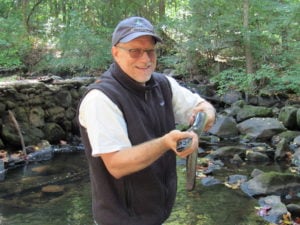Hudson River fish: The springtime procession
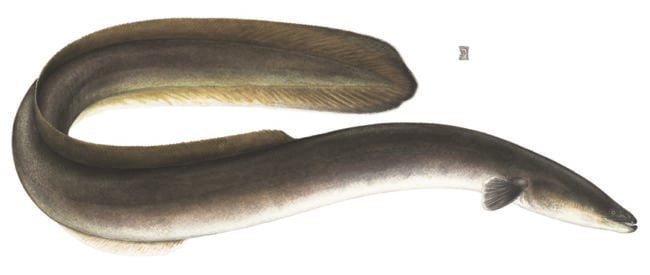
New York DEC
View more images on our Flickr site
Here’s what’s happening beneath that sheet of water.
The Hudson River Estuary, from New York Harbor to Troy, is as wild as any wilderness on earth.
Every spring, a procession of species is driven by natural forces to return here from the Atlantic.
This wilderness is hidden. We look out and see a sheet of water. But there’s so much happening in there.
These historic Hudson River fish migrations are miraculous. And if we want to keep these migrations alive, we need to pay attention, and act. Riverkeeper is fighting to restore the abundance of these migratory fish. You can get involved by signing up for emails, supporting the Restore Mother Nature bond act and learning about the benefits of dam removal along the creeks and streams that feed the Hudson.
Triggered by the sun’s energy and other seasonal cues, migratory fish find their way back to the rivers where they were spawned. They follow timeless instinctual patterns written into their DNA that allow them to determine their location and direction of travel in relation to the Earth’s magnetic field. Their sense of smell helps them pinpoint their natal waters. They navigate a watery realm – dark, turbid, devoid of landmarks – similar to the way we use a map and compass to find our way through a dense forest. Eels follow a reverse pattern, entering the estuary as juveniles and returning as adults to the Sargasso Sea; we don’t fully understand how they accomplish this.
Migration is a brilliant evolutionary strategy. The fish adjust their bodies to transition from saltwater to fresh. Tucked away in the protected reaches of rivers and tributaries, juvenile river herring, shad, striped bass, shortnose sturgeon, Atlantic sturgeon and eels are allowed to mature with less danger than they would encounter in the ocean.
As scientists, we’ve tried to map these fish migrations using conventional tags, sonic tags and sonar buoys, and even satellite transmitters. We’ve also studied the chemistry of ear bones (otoliths) of certain species – they have patterns similar to tree rings, which allow us to reconstruct their origins and migration patterns.
I’m still mystified by these amazing creatures and their movements. Anytime I pick up a fish, I can only wonder: Where were you, and how did you find your way here?
The seasonal migrations are just a whisper compared to the torrent they once were. So it’s worth our time to follow our natural curiosity when we look out at that sheet of water: What’s in there? What’s going on under that surface?
Here are some highlights of what’s happening.
In late autumn and early winter, fish prepare to survive the coldest weather, and in some cases enter periods of dormancy. Some species remain in warmer coastal waters. Some can remain in the estuary itself because of enzymes or glycogen in their bloodstream that allow them to survive the coldest temperatures. Some fish and crabs bury themselves in the mud, or head for deeper waters. Blue crabs often remain buried until May.
Tomcod
Also known as the frostfish, tomcod move upstream to spawn in late autumn and early winter when the first frosts occur. They are tolerant of freezing water because of blood proteins that prevent ice crystals from forming. They are the only member of the cod family in the estuary, and rarely stray far from it. Frostfish are vanishing from the Hudson, with climate change pushing them northwards.
Rainbow smelt
Smelt, with an elongate, slender body, travel in large schools in coastal waters and migrate into estuaries in late fall and early winter. In late winter and early spring, smelt follow the thaw upstream to spawn in rocky stretches just above the head of tide. Like other cold-tolerant fish, smelt produce antifreeze proteins and seasonally regulate glycerol, allowing them to remain active in the coldest of winter waters.
Creeks and tributaries once teemed with rainbow smelt from New Jersey to Labrador in the spring. However, rainbow smelt are no longer found in the Hudson River – only north of Connecticut. Exploitation and alteration of habitat, in conjunction with climate change, have diminished their numbers and forced them northward. It’s a cautionary tale for other species.
American eel
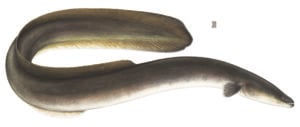
New York State DEC
Born in the Sargasso Sea, eel larvae follow the Gulf Stream and leave the warm, flowing currents by following gyres that lead them inland. They follow geomagnetic cues and the smell of freshwater plumes emanating from coastal rivers. There they transform into “glass eels.”
By February, citizen scientists in Yonkers begin counting them in a fyke net. The glass eels pick up tidal pulses, seeking the security of the freshwater habitat upstream until they develop into sexually mature “silver eels.”
American eels defer spawning until late in life, with some females living 20 to 30 years before becoming sexually mature. It is believed that the sex of eels is determined by environmental conditions. The largest and most northern eels tend to be females. At some point, they are cued to journey back to the Sargasso Sea to spawn and die. With their numbers severely diminished, Riverkeeper is seeking increased protections in New York.
River herring
There was a time when this suite of fish, including the closely related alewife and blueback herring, were wildly abundant, arriving into local rivers and creeks by the millions and heralding the onset of spring. Sadly, these species are in serious decline and showing little rebound.
The food web is most stable and resilient when these species are found in high abundances.
From eggs to larvae, juveniles to adults, alewives and blueback herring are a preferred prey for multitudes of species including striped bass, largemouth bass, smallmouth bass, bluefish, tuna, cod, sharks, eagles, osprey, herons, cormorants, mink, raccoons, opossums, seals, whales and dolphins. Once hatched, juvenile river herring remain in freshwater nursery areas in spring and summer, feeding mainly on zooplankton. In late summer and early autumn, the juveniles move downstream to saltier waters and out to sea. Female blueback herring reach maturity between ages 3 and 5, and can lay 60,000 to 400,000 eggs each.
Alewives
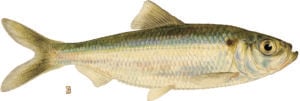
New York State DEC
These fish generally enter creeks and tributaries to spawn in late March to mid-April – a thin, silver fish with grayish-green back, smooth scales and large eyes for their size. A dark shoulder spot appears behind the head on fish greater than 3.9 inches long. Adults grow to 15 inches, females larger than males. Alewives prefer to spawn in shallow, sluggish waters along large rivers, small streams and ponds.
Bluebacks
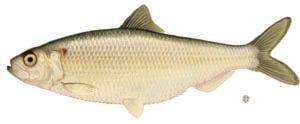
New York State DEC
Blueback herring enter the creeks and tributaries to spawn in late April to mid-May. They are a silvery fish w
ith a blue-green back and a spot on the shoulder. Like the alewife, they have spiny scales, called scutes, along the belly. Its fins are slightly yellow to green, with a branched pelvic fin and a short anal fin. They are very similar to alewives but have a smaller eye and are slightly smaller. Blueback herring prefer to spawn in swift-flowing, deeper stretches of river and streams with associated hard substrate.
Shad
Shad are the larger cousins of river herring, spending most of their adult lives in marine waters and moving in from the ocean to spawn in freshwater in springtime. They spawn in the main stem of the Hudson and the largest of creeks during the month of May.
Like river herring, shad do not eat during their return to freshwater, relying on stored reserves to sustain themselves during migratory journeys. Before the Susquehanna River was blocked by dams, American shad would make 600 mile round trip spawning forays to the headwaters, near Otsego Lake. They are marathon runners, built by design to travel many thousands of miles over the course of their lives.
At one time there were 400 shad fishing operations in the Hudson River. running six days a week during spring migrations. As a result of their depleted status, all commercial fishing for American shad has ceased. Riverkeeper has petitioned the DEC to increase protections on shad, making them a “species of concern.”
American shad
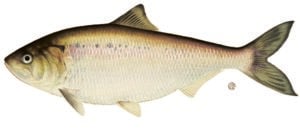
New York State DEC
The largest of the shads have a bright metallic coloration that varies from greenish to dark blue. They have a large dark shoulder spot that may be followed by several smaller, paler spots, and large, easily shed scales that come together at the belly to form a saw-toothed edge. These fish are built for speed and have a deeply forked tail fin. Females, called “roes,” are larger than males, or “bucks.”
American shad are spectacular in both form and evolutionary function. They are an important prey for maturing striped bass. They “saved America” several times. During the harsh winter of 1778, Washington’s army was saved by the American shad. During the World Wars when it was too dangerous at sea, it was the fishing of shad in the rivers that saved Americans from starvation.
Hickory shad
Hickory shad move into rivers in June and spawn in freshwater. They are very similar to American shad but noticeably smaller, 12 to 20 inches. Less is known about them, because they have low commercial value. The larvae begin feeding within a week after hatching and drift downstream toward the lower estuaries and mouths of rivers. It is believed that juvenile hickory shad do not use the same freshwater nursery areas as river herring and shad, but prefer higher salinity water. In early to late summer, juveniles return to the sea. Unlike American shad, they feed mainly on small fish and squid.
Striped bass
One of the most iconic and charismatic species in the Hudson River, striped bass typically spend the majority of their lives in coastal estuaries or the ocean, migrating north and south seasonally and ascending rivers to spawn in the spring. Spawning generally occurs in May and early June. They are a preferred target of anglers.
Stripers have distinctive markings, with a dark, olive-green to bluish-black back and silvery-white sides and belly and seven to eight black, unbroken, horizontal stripes along the side. Striped bass can live for 30 years and weigh as much as 70 pounds. They are a voracious predator, consuming almost anything they can fit into their mouths.
In the river, stripers will feed on river herring and shad, but menhaden (bunker) are their preferred prey in marine and estuarine waters. This most favored fish is in decline because of recreational overharvest. Riverkeeper has helped fight for tighter coastwide restrictions to protect the spawning stock.
Atlantic sturgeon
Sturgeon are particularly well adapted to living in deep, dark, and murky waters, using their barbels and electrochemical sensors to detect prey and navigate into the ocean and back to their natal spawning sites. They spawn in the Hudson from April to June, upstream of the salt front. After spawning, female Atlantic sturgeon will move out of the Hudson River, while males may remain until the fall.
In the Hudson they are listed as endangered by state and federal regulation. They are an ancient fish whose ancestors date back nearly 230 million years to the Triassic Period, when dinosaurs roamed the planet. The species itself hasn’t changed much in the last 120 million years.
Sturgeon are gentle giants, somewhat shark-like in appearance. They are slow growing, late maturing fish that can live 80 years and grow as large as 14 feet long and 800 pounds. Five rows of bony plates, or scutes, run along their bodies. The elongated snout has four slender, soft tissue projections, called barbels, in front of their mouths.
Female Atlantic sturgeon reach sexual maturity around 20 years of age, when they are 6 to 8 feet long and over 70 pounds. Males become sexually mature at about 15 years. After spending up to seven years of life in freshwater, juvenile Atlantic sturgeon migrate out to sea to spend the rest of their lives. Only during spawning season do adult sturgeon return to large coastal rivers and estuaries. Unfortunately, many are killed by boats and their propellers.
Shortnose sturgeon
Unlike Atlantic sturgeon, shortnose sturgeon seldom leave their natal river, migrating between freshwater and the more brackish river reaches. Between April and May, adult shortnose sturgeon migrate up the Hudson River from their overwintering areas to spawn in upper, freshwater areas. Males spawn every other year and females every third year.
In the Hudson they are listed as endangered by state and federal regulation. Like their larger cousin the Atlantic sturgeon, the shortnose is an ancient fish with many of the same physical adaptations. They average 3.5 feet long and, true to their name, have a shorter snout.
Sea lamprey
One of the most ancient groups of all vertebrates, sea lamprey are considered to be largely unchanged for the past 500 million years. The eel-shaped animals spend a major part of their life (5 – 7 years) as harmless, blind, filter-feeding larvae buried in the sediments of freshwater streams. Upon metamorphosis, these “transformers” migrate downstream to the ocean and become parasitic, feeding on the blood and bodily fluids of other fishes. After about a year and a half at sea, they return to freshwater streams and rivers in April to June to spawn and die.
Sea lampreys are native to the Hudson and other coastal rivers, and pose no threat to our ecosystem. In their native range, predatory fish such as bluefish and striped bass will readily devour them. Their carcasses play a critical role in cycling important marine nutrients into freshwater ecosystems. They are often maligned because of their presence in the Great Lakes, which they entered through human-built canals, and where they became a problem to fishes and an ecosystem not adapted to them. They are imperiled throughout much of their native range, but due to their reputation, little attention is given. There is a movement to save lampreys in coastal rivers where they belong.
Blue crab
From May to October, blue crabs mate in brackish water. Immature female crabs called “Sallys” move upriver where the males, called “Jimmys,” are concentrated. Males cradle the Sallys and upon shedding of her shell for the last time, the sexually mature female known as a “Sook” is ready to mate. Jimmys cradle soft-shelled Sooks in their legs, protecting and carrying them for several days until their shell hardens. Females carrying egg masses are known as sponge crabs, which then move to the high salinity waters of the lower estuary to release their many million eggs, while Jimmy seeks another Sally. Once the eggs hatch, the larvae are known as zoea undergo seven stages. Very few eggs survive to reach adulthood. Jimmys remain in fresh and brackish waters throughout their lives, and have been found as far north as the Troy Dam.
Saving these fish
“Diadromy” – the migration between saltwater and fresh – was a brilliant evolutionary strategy. That is, until humans began using advanced technology in ways that decimated the numbers of all of these species.
Largely within the past two centuries, humans built dams on almost every creek and tributary of the Hudson River to operate machinery, walling off habitat. We harvested too many fish of almost every species, and built power plants that draw in river water and destroy aquatic life. Flowing water was treated as an open sewer for human waste and industrial contaminants. All this occurred at the expense of the wild organisms that use this river as a critical corridor for all or part of their lives.
Diadromous fishes need unimpeded access to healthy rivers and protection in the open ocean, where they are being decimated by commercial fisheries intent on other species.
Riverkeeper is advocating for these fishes in many ways, but we are primarily focused on ridding the Hudson River tributaries of obsolete barriers that do little more than block these fishes from their rightful habitat.
We’ve taken the first steps. Read about the landmark dam removal at Wynants Kill, a collaboration by Riverkeeper, the City of Troy and the Department of Environmental Conservation. We have also reached agreements with several municipalities to remove several decrepit dams from Hudson River tributaries.
The health of the Hudson River ecosystem is closely tied to the fate of its native fishes. Let’s do everything we can to bring them back from the brink and start to heal this living river.
Learn more

